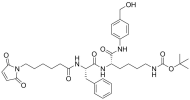Phe-Lys(Boc)-PAB is a chemical compound that is widely used in pharmaceutical research and development. It is a peptide derivative composed of three amino acids: phenylalanine (Phe), lysine with a tert-butyloxycarbonyl (Boc) protecting group (Lys(Boc)), and p-aminobenzoic acid (PAB).
The amino group of lysine and the carboxylic group of PAB allow for the attachment of drugs or other molecules via amide bond formation, while the phenylalanine residue provides hydrophobicity to the peptide. The Boc group on lysine can be removed under mild conditions to expose a free amine group for further conjugation.
Phe-Lys(Boc)-PAB has been used in the design and development of targeted drug delivery systems. The lysine residue in the peptide allows for specific binding to cell surface receptors, while the PAB residue enables pH-dependent release of the drug cargo in the target cells. The hydrophobic phenylalanine residue also plays a role in increasing the stability and solubility of the peptide-drug conjugates.
Phe-Lys(Boc)-PAB has also been utilized in the development of imaging agents for diagnostic purposes. By attaching fluorescent or radioactive probes to the peptide, it can be used to target specific tissues or cells in vivo for imaging or detection.
Phe-Lys(Boc)-PAB
| Cat# | Name | Structure | Pricing |
|---|---|---|---|
| AP14619 | Mc-Phe-Lys(Boc)-PAB | Pricing | |
| AP14620 | Fmoc-Phe-Lys(Boc)-PAB | Pricing |



